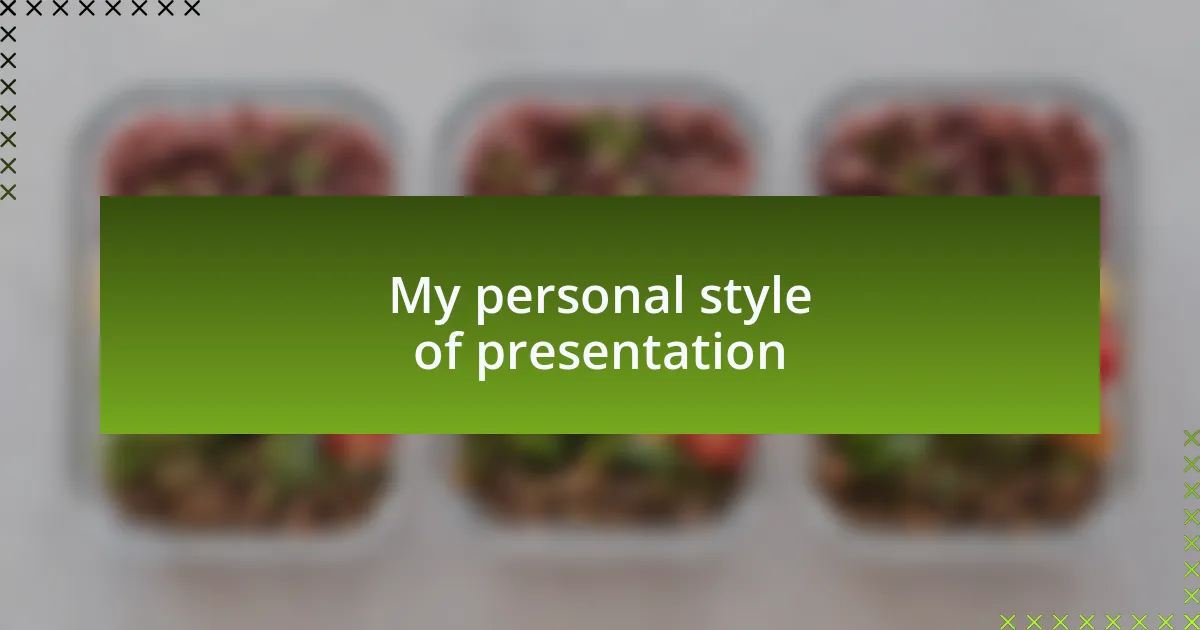Key takeaways:
- Food presentation combines colors, textures, and shapes to create an emotional dining experience, engaging diners even before tasting the dish.
- Elements such as balance, height, and thoughtful garnishes significantly enhance the visual appeal and overall enjoyment of a meal.
- Techniques like negative space, layering, and contrasting colors help in conveying a narrative and elevating the perception of the dish.
- Personal style and the choice of serving vessels can greatly influence the atmosphere and intimacy of the dining experience.

Understanding food presentation
Food presentation goes beyond mere aesthetics; it’s an intricate dance of colors, textures, and shapes designed to elicit emotions and create an experience. When I plate a dish, I often ask myself, “What story am I telling?” Each element on the plate should contribute to the narrative, engaging the diner in a way that stimulates their senses before the first bite is even taken.
I recall a dinner I attended at a fine dining establishment where the entrée looked like a work of art. The chef had arranged the vegetables in a circular pattern, surrounding a perfectly cooked piece of fish, which was garnished with a delicate sauce. The vibrant colors not only caught my eye but also heightened my anticipation. It made me appreciate how presentation is a crucial aspect of the culinary experience, turning a meal into a feast for the eyes.
Every detail counts in food presentation. I learned this during my journey in the kitchen when I realized that even the smallest garnish can transform a dish. For instance, a sprig of fresh herbs not only adds flavor but also brings brightness to the plate. So, when you think about food presentation, consider how each component can elevate the dining experience—it’s about balance, harmony, and the impact on the diner’s emotions.

Importance of food presentation
Food presentation plays a pivotal role in how diners perceive a dish. I remember the first time I encountered a dessert that was so beautifully presented, it almost seemed a shame to eat it. The delicate layers of a chocolate mousse, artfully arranged with a sprinkle of edible gold, made me pause and appreciate the skill involved. It’s fascinating how a visually appealing dish can transform a simple meal into an extraordinary experience, igniting excitement and anticipation.
When I craft a plate, I often think about how the arrangement can influence the overall taste perception. For instance, consider a salad—if each ingredient is distinctly visible, showcasing their vibrant colors and textures, it invites curiosity and excitement. This meticulous attention to detail doesn’t just enhance the visual appeal; it sets a tone for the entire dining experience. Have you ever noticed how the presentation of food can stir your emotions? It truly can turn an ordinary meal into something memorable.
Moreover, the impact of food presentation extends beyond just the individual plate. In moments of personal reflection, I’ve realized that when I invite friends over, the way I present a meal sparks conversations and creates a warm atmosphere. It encourages everyone to engage and share their thoughts about the dishes. Great presentation ignites curiosity and admiration, inviting diners to explore the flavors with a sense of wonder and connection, making every meal a celebration.

Elements of fine dining presentation
When considering the elements of fine dining presentation, I often reflect on the importance of balance and harmony on the plate. I recall attending a memorable gala where a chef had perfectly arranged a dish with vibrant greens, tender proteins, and a rich sauce, all guiding the eye and enhancing the overall experience. Each component felt intentional, reflecting not just skill but a deep understanding of color theory and composition. Have you ever noticed how a dish with balanced elements appears more appetizing simply because it feels ‘complete’?
Another critical aspect is the use of height in plating. I remember watching a talented chef layer ingredients to create towering presentations that drew everyone’s attention. The way he used verticality not only added depth but also made the meal feel like a work of art. It’s a fascinating technique that encourages diners to appreciate the craftsmanship involved. Doesn’t a dish that plays with height invite you to dig in and explore?
Lastly, garnishes can elevate a dish from ordinary to extraordinary. I often enhance my home-cooked meals with fresh herbs or vibrant purées that add a pop of color and an extra layer of flavor. I vividly recall serving a simple risotto topped with microgreens and a hint of lemon zest, which ignited compliments and conversations around the table. Have you considered how such small touches can turn a simple dish into a talking point? Garnishes invite sense engagement, making each bite a thoughtful experience.

Techniques for plating dishes
One technique I often use is the “negative space” method, which involves leaving parts of the plate empty to create visual intrigue. I once watched a chef expertly place a small portion of beautifully seared scallops against a wide expanse of creamy cauliflower purée. The contrast was striking, and it drew your eye immediately to the scallops, elevating the dish’s appeal. How often do you appreciate that space around the food as much as the food itself?
Next, I have a deep appreciation for the art of layering ingredients in a way that narrates a story on the plate. During a cooking class, I experimented with stacking roasted vegetables atop a smooth polenta base. Not only did this create an engaging visual, but the combination of textures made each mouthful a delightful surprise. Have you considered how the arrangement of ingredients can influence the dining experience?
Finally, I believe color plays a vital role in plating. The first time I created a dish that highlighted vibrant reds, greens, and yellows, I felt as if I had painted a canvas instead of merely plating food. Using contrasting colors not only catches the diner’s eye but also evokes emotions, like joy and excitement. Don’t you think that a colorful presentation can make you feel more eager to indulge?

My personal style of presentation
When it comes to my personal style of presentation, I focus on creating a narrative that draws the diner in. I remember the first time I plated a dish inspired by a vibrant garden. I artfully arranged bright heirloom tomatoes, crunchy arugula, and delicate microgreens, allowing each element to tell a part of the story. Does the arrangement of ingredients make you feel like you’re experiencing a journey through nature?
One of my favorite techniques involves the use of unique serving vessels. I once served a dessert in a small, rustic wooden bowl, which not only added an earthy touch but also made the dish feel more intimate. It’s fascinating how the choice of dishware can elevate the presentation and influence the overall dining experience. Have you ever noticed how a simple change in serving style can transform familiar flavors?
Lastly, I embrace the concept of “garnish” in a way that’s less about decoration and more about enhancing flavor. There was a moment while plating a delicate fish dish when I decided to infuse the plate with a few edible flowers—each adding a hint of flavor and a burst of color. I truly believe garnish should be purposeful. Don’t you agree that every element on the plate should serve a purpose, further enhancing the culinary experience?

Tips for enhancing visual appeal
To enhance the visual appeal of a dish, consider the impact of color contrast. I vividly remember plating a rich beet salad where the deep purples danced alongside vibrant greens and a sprinkle of creamy goat cheese. The contrasting colors not only grabbed attention but also created a sense of harmony. Have you ever realized how a simple color choice can evoke emotions?
Another useful tip I swear by is the importance of negative space. When plating, I often leave portions of the plate empty, allowing the eye to focus on the food itself. I once arranged delicate slices of sashimi with a touch of wasabi, and the surrounding white space made the dish feel elegant and sophisticated. Isn’t it interesting how often less can truly mean more?
Finally, don’t underestimate the power of texture. When I once plated a dish with crispy fried shallots on top of a velvety purée, the combination not only looked appealing but also promised a delightful contrast in every bite. Texture can turn an ordinary presentation into something memorable. How do your favorite dishes play with different textures to create a more engaging dining experience?

Case studies of my presentations
One memorable presentation involved my take on a classic seafood dish. I chose to layer scallops atop a bright green pea puree, drizzled with a tangy citrus reduction. The pop of color from the peas next to the elegant, seared scallops created a playful yet sophisticated design. I could see the delight in my guests’ eyes as they marveled at the dish before even taking the first bite—did you know that visual appeal can enhance the overall flavor experience?
During another event, I experimented with height in my plating. Using a tower of roasted vegetables, I positioned them vertically to draw the eye upward. The vibrant colors of the roasted red peppers and yellow squash shone against a delicate white plate, creating a stunning presentation that invited curiosity and conversation. How often do we overlook the impact of height in a dish, and yet, it can elevate the dining experience to an art form?
I also recall a unique dessert I crafted, utilizing a mix of components that required careful arrangement to tell a story. The rich chocolate tart was placed beside a smear of raspberry coulis, and a small scoop of lavender ice cream crowned the dish. Each element, placed thoughtfully, combined flavors and emotions—sweetness, tartness, and an unexpected floral note. Isn’t it fascinating how a well-plated dessert can transform dessert into a moment of pure joy?